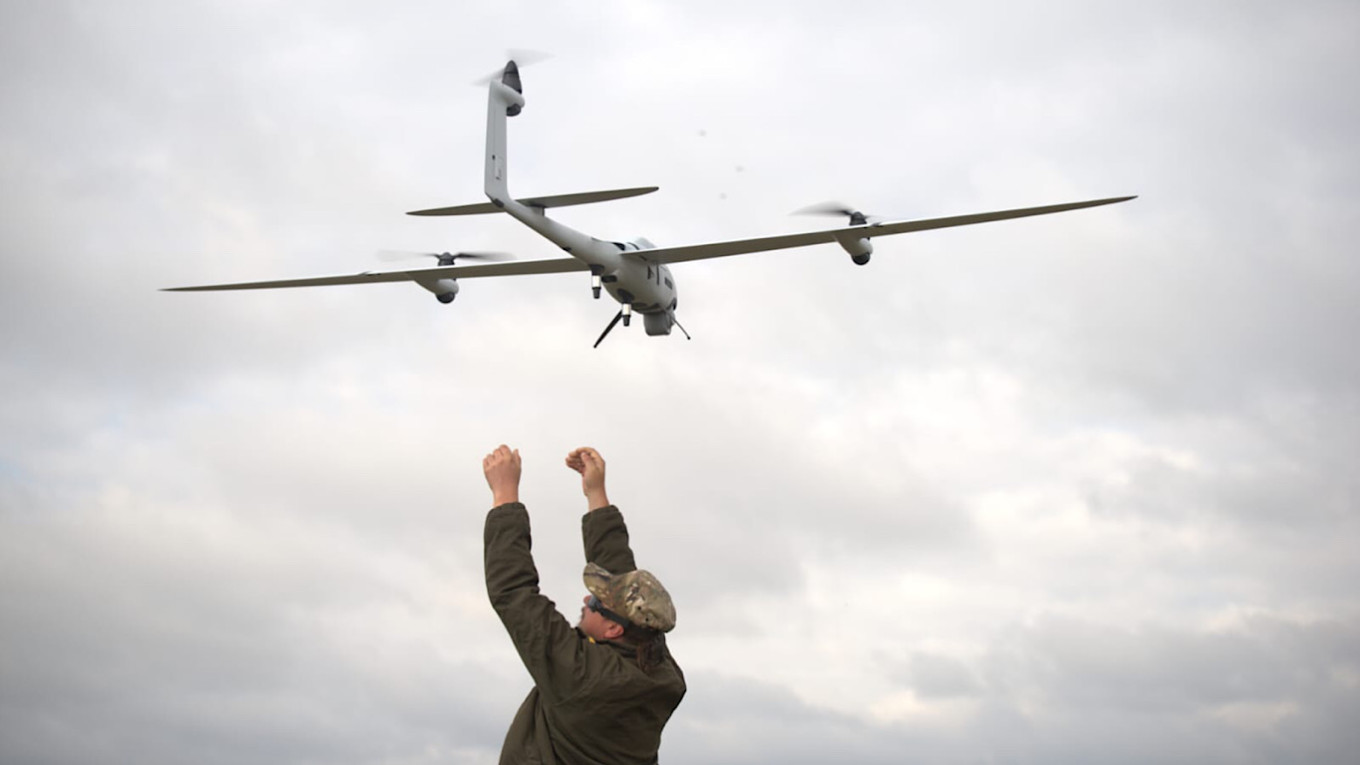**KHERSON REGION, Ukraine** — At 11 a.m., we navigate our vehicle onto the M-14 roadway connecting Mykolaiv and Kherson.
“Today’s weather is on our side,” my companion, local journalist Svitlana Horevaya, observes while gesturing toward the cloudy, drizzly sky. “The visibility from above is poor for the Russian drone operators, which makes us safer.”
The M-14 serves as Kherson’s sole dependable route linking it to the rest of Ukraine. This vital supply route has been vulnerable to Russian drones since mid-July, with alternative paths even more susceptible to artillery and UAV assaults.
Horevaya elaborates, “For Kherson, this presents a significant logistical hurdle. All essential supplies — food, humanitarian aid, and medicine — traverse this road, including transport for civilians. … Any intensification of attacks on this route could result in a dire situation.”
The extensive deployment of first-person-view (FPV) drones, inexpensive devices constructed from readily available components, has altered the landscape of modern combat since the onset of Russia’s large-scale invasion of Ukraine.
Since 2023, both Ukrainian and Russian forces have widely adopted this technology, with rapid advancements in capabilities.
As explosive payloads become more destructive and electronic warfare systems evolve, the most significant battlefield transformation has been the extended flight range of drones.
The previously limited “kill zone” of five to ten kilometers has now expanded to as much as 20 kilometers, and in certain instances, even 30 to 40 kilometers.
This change has significant implications. In recent months, Russian drone units have intensified attacks on rear areas of Ukraine, particularly targeting supply lines essential for Kherson, the main Ukrainian stronghold in the south. Since July, they have partially disrupted these routes, systematically striking civilian vehicles and transport trucks with FPV drones.
By September, Russian efforts to disrupt supply routes had been mirrored in the east, with attacks targeting the Kharkiv-Sloviansk highway, a crucial logistical route for Ukrainian forces in the Donbas region.
Our travel along the M-14 was meticulously planned; the risk of attacks increases after dark.
However, Ukrainians have adapted to the threat. Parts of the highway are now shielded with improvised anti-drone nets made from large fishing nets hung on wooden poles. Another local innovation is a drone traffic light system, which detects incoming UAVs and halts vehicular traffic until it is safe to proceed.
The most effective defensive measures continue to be the electronic warfare and anti-drone units stationed along the highway. Their presence has significantly decreased the destruction of vehicles, but complete protection of the entire route remains unfeasible, with Russian drones still taking advantage of unguarded areas.
Part of the challenge stems from Russia’s technological advancements. In 2024, they began deploying the Molniya, a new fixed-wing UAV crafted from basic materials like plywood and aluminum.
Despite its simple construction, it has become an effective weapon capable of reaching targets more than 30 kilometers away.
These drones are being actively utilized in the Kherson region.
“Molniya drones have been recorded in the air for several days,” Horevaya noted. “They are extending their range and striking at locations that typical FPVs can’t access, getting closer to the boundary between Kherson and Mykolaiv regions. This naturally complicates our defensive efforts.”
Russian forces employ various strategies to launch FPV drones. Some are released from “motherships”—large multi-rotor hexacopters or octocopters that function as airborne launch platforms. Others are transported by Molniya UAVs or directly deployed by operators, which restricts range but can be enhanced through relay drones.
Occasionally, Russian troops have utilized fiber-optic-controlled drones that are immune to radio interference.
However, the Molniya drones along with motherships can serve as both carriers and relays, significantly increasing the operational range of FPV drones, explains Ukrainian military analyst Oleksandr Kovalenko.
“This capability allows FPV drones to be launched from 30 to 40 kilometers away from the front lines, enabling them to target vehicles, personnel, and stationary objects,” he elaborates.
Kovalenko indicates that drone motherships are particularly effective, increasing both flight duration and distance.
This development clarifies the rise in Russian assaults on Ukrainian supply lines in the southern and eastern fronts. In proximity to the M03 highway connecting Donetsk and Kharkiv, Russian forces have made advances in the Lyman district, shortening their distance to one of Ukraine’s primary logistical routes in the Donbas.
“As the frontline approaches us, so do their drone operators,” states Yevhenii, a Ukrainian soldier specialized in UAV operations who requested to remain anonymous. “The drone mothership can penetrate deeper into our territory.”
Nevertheless, Ukraine’s drone units are retaliating in kind.
“We exploit the same vulnerabilities as the Russians — we also operate within their lines, flying for dozens of kilometers,” Yevhenii remarks.
Kyiv has developed interceptor drones capable of neutralizing enemy UAVs and has also created its own motherships and fixed-wing versions of the Molniya. These innovations have proven effective enough to prompt Russia to begin developing comparable systems.
Kovalenko describes these initiatives as “active defense” — eliminating drone launch platforms and their operators before they can execute attacks.
“Beyond shooting down drones when it’s feasible, targeting their launch sites serves as an effective strategy for active defense. Locating and diminishing the number of drone operators is vital,” he asserts.
On the eastern front, the disparity between the two forces varies significantly.
“Our Russian counterparts match us in skill,” admits Yevhenii, “but they outnumber us and possess more resources.”
This uneven distribution is particularly stark in the Dnipropetrovsk region where he is stationed.
“As my senior comrade put it, it’s a bloodbath. During favorable weather conditions, both sides are constantly airborne. However, if an opponent’s reconnaissance drone appears, we might send one interceptor while they launch three or four kamikaze drones simultaneously.”
Kovalenko believes this disparity is localized to that section of the frontline, where the Russians have amassed four combined-arms divisions along with a corps of motorized rifle regiments and reserves — approximately 100,000 troops.
“We have far fewer personnel in this area,” he states. “It’s a very challenging situation for us.”
Faced with ongoing personnel shortages, Ukraine is concentrating on developing unmanned systems to safeguard soldiers’ lives.
While Kyiv maintains an advantage in drone technology for now, Russia is rapidly narrowing that gap.
“In March and April 2024, they operated around 250 FPV drones daily. Now, they are deploying between 1,000 to 1,200 drones per day — often even more,” Kovalenko points out. “In August, they reached a peak: approximately 30,000 FPVs were used in a single month. That’s five to six times what they deployed a year ago.”
Russia is capable of launching between 4,500 and 8,000 FPV drones each week, often influenced by weather conditions or supply limitations.
Moscow continues to heavily depend on imports from China for dual-use items, including both complete drones and components, Kovalenko noted.
In August, Ukrainian engineer and communications specialist Serhiy “Flash” Beskrestnov reported that recovered footage from a downed Russian Gerbera strike drone contained video files from camera tests conducted at a Chinese manufacturing facility.
The interface suggested that the drone might use “machine vision” capabilities to autonomously identify vehicles, reflecting advancements in automation.
Kovalenko emphasizes that the Russians lack sufficient capabilities to produce drones independently of Chinese support. However, while Ukraine initially leveraged FPV drones to counterbalance its personnel shortages, Russia’s accelerated production could soon eliminate that advantage.
“If this trend continues, Russia could achieve parity with our forces in the use of FPV drones by the end of this year,” he cautions.

